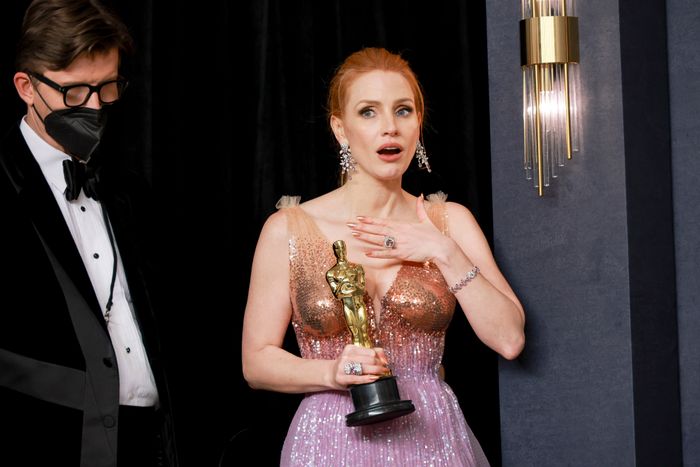
Less than 24 hours after one of the wildest Academy Awards incidents in show history, the general consensus is that the Slap — the moment Will Smith smacked Chris Rock for telling an admittedly ill-advised joke about Jada Pinkett-Smith’s shaved head — derailed the entire ceremony. Which is true. The incident, which occurred two and a half hours into the proceedings, threw everything off balance and overshadowed the significance of each moment that followed. As a consequence, the conversation about what did or didn’t work about this year’s broadcast — one set in motion weeks before the ceremony — has also been derailed.
And a lot didn’t work. For years, the Oscars has tried to be a jack of all trades. It wants to be a live event flying by the seat of its pants while cultivating a highly managed, positive image of Hollywood. It aims to sell the public on going to the movies and visiting its brand-new $482 million Museum of Motion Pictures. It’s also striving to be an entertaining piece of television that brings in lots and lots of viewers. As co-host Wanda Sykes put it: “We’re here at the Oscars, where movie lovers unite … and watch TV.” Under the supervision of producer Will Packer, this year’s Oscars attempted to be all things to all people and ended up effectively serving no one. Sunday’s ceremony stretched itself in so many directions it basically broke every bone in its own body.
The event had three hosts in Sykes, Amy Schumer, and Regina Hall, and it parceled out music duties to three different entities: DJ D-Nice, a band with Sheila E. on percussion, and an orchestra. The main telecast was overstuffed with emcees but excised eight categories that were presented during a pre-ceremony despite protests from many in the industry. Oscars producers inserted truncated versions of those earlier presentations into the prime-time broadcast anyway in a manner seemingly designed to confuse viewers at home. (There’s something profoundly ironic about removing the Best Editing category, then editing it back in a way that demonstrates exactly why good editing is so crucial.) The changes saved little if any time; the Oscars still ran past 11 p.m. ET.
This is in part due to the producers’ decision to add extra segments including the results of polls conducted online to determine which movies were popular with fans. In an effort to show the Academy understands what the people want, the Oscars wound up highlighting such works as Johnny Depp’s obscure Minamata, a movie fewer people have seen than CODA or The Power of the Dog. The broadcast also engaged in a constant tug-of-war between celebrating the new movies the Oscars are supposed to honor and wallowing in nostalgia for older worlds with reunion-style award presentations by cast members from Pulp Fiction, White Men Can’t Jump, and Juno as well as tributes to The Godfather and the James Bond films, the latter presented by extreme-sports icons, obviously. It was as if Packer couldn’t make any decisions and therefore opted to do everything.
Even the best moments of the night came across as too calculated. Beyoncé opened the show with a performance of her Oscar-nominated song “Be Alive” from the film King Richard. In classic Beyoncé fashion, the production was meticulously choreographed, paying tribute to the Williams sisters on a tennis court in Compton, where they first came into their greatness. Beyoncé being Beyoncé, it was compelling and enriched by intense attention to detail — the dancers surrounding her sported Venus Williams’s famous braids and were dressed in tennis-ball green, while Beyoncé wore earrings and a necklace that resembled a Wimbledon trophy. You could see exactly how this checked boxes for the Oscars planners: It placed a Black artist and two phenomenal Black athletes at the center of things right from the jump, ensuring viewership in the first few minutes. And by staging the performance remotely from Compton, the Oscars sent a message that its worldview extends beyond Hollywood (20 whole miles away from Hollywood, at least). But because Beyoncé wasn’t actually onstage inside the Dolby Theatre, the segment felt divorced from the Oscars. Unlike the rendition of “We Don’t Talk About Bruno” that came later in the night, “Be Alive” didn’t amp up the excitement or engage the VIPs in the auditorium. The energy was unfolding somewhere else.
Even the unfortunate buzzy moments of the night — the Slap and Smith’s acceptance speech for Best Actor addressing it — were handled clumsily. There should be no one more adept at responding to unforeseen television surprises than experienced professionals who oversee live shows. But when the Slap happened, ABC cut the audio, forcing viewers to rush to the internet to watch unfiltered video clips via Australian and Japanese broadcasts. During Smith’s speech, the feed cut to an “Oscars on ABC” title card for what felt like an excruciating amount of time, possibly because Venus Williams, who appeared in a reaction shot, had a minor wardrobe malfunction. I understand the concern about FCC fines, but the bleeping and awkward camera decisions felt as if the producers were trying to control what was happening even though this is exactly why people watch live events like the Oscars: to witness unscripted, unedited moments in real time.
As much as Oscars organizers say they want to embrace live television and create an event that’s exciting and spontaneous, that’s not actually what they want. They want to stage an event that seems spontaneous but is as carefully choreographed as a Beyoncé performance or Godfather clip package. Chaos is fine as long as it’s planned, controllable chaos. When unanticipated events transpired Sunday night, the illusion fell apart.


